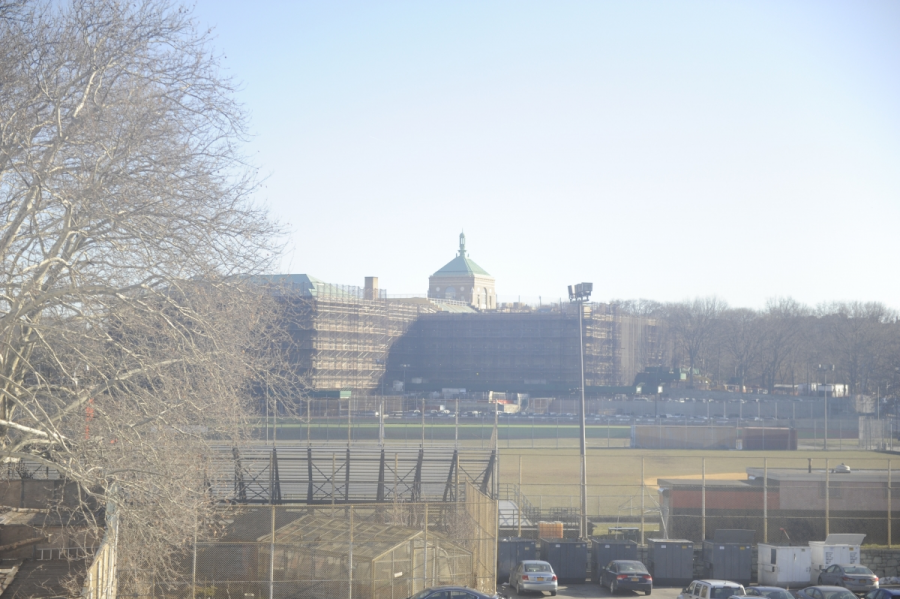De Blasio’s School Renewal Program Spirals to Failure
DeWitt Clinton High School is one of the many NYC DOE schools in the renewal program.
In a typical high school classroom, students furiously scribble notes as the teacher quickly flips through powerpoints. On some days, fifteen hands shoot up in the air to participate in a friendly discussion, while on others mouths spit fire during a heated debate. With only a teacher and thirty -four students, the room emits a lively aura. Mayor De Blasio aspired to provide such a valuable experience for every child in New York City. He outlined a vision in stark contrast to the policies of his predecessor, Michael R. Bloomberg. Where Bloomberg closed schools that had performed poorly, opening hundreds of new, smaller schools in their place, De Blasio said that troubled schools would be wrapped in supports. He promised fast and intense progress.
The Department of Education originally announced the Renewal Program in November 2014. Among the schools participating in the program, forty-three are located in the Bronx, twenty seven in Brooklyn, twelve in Manhattan, and twelve in Queens. The ninety-four schools were identified by the State as Priority or Focus Schools. In other words, they have demonstrated low academic achievement for each of the past three years, ranking in the bottom twenty five percent of City schools on Math and ELA state exam scores or graduation rates, and showed limited capacity for improvement with a rating on their most recent Quality Review of “proficient” or below.
De Blasio pledged to flood the city’s lowest-performing schools with support to lift the performance of the identified struggling schools. Each school in the program has had an additional hour added to its school day. Teachers receive extra instruction in how to teach. Schools are paired with community-based organizations to address the needs of students and their families outside the classroom such as mental health counseling, dental care, and support to help make sure students come to school. By the end of this school year, the city will have spent $582 million on Renewal, yet there is scant evidence that the schools have made significant improvement.
Three years into the nation’s largest turnaround initiative, the department intends to close or merge fourteen schools in the program, while moving twenty-one other schools which have shown progress, out of the program. Coming after smaller rounds of closings and mergers, the changes will leave forty six schools in the program, less than half the number at its inception three years ago.
Recently, the Panel for Educational Policy held a meeting on behalf of shutting down a few schools. The board is comprised of thirteen members appointed by the mayor and borough president, and is part of the governance structure of the DOE. In particular, they vote on policy and make decisions about school closures and consolidations. During the official meeting, they had reached a conclusion that the schools must be closed permanently.
Enraged by the decision, many parents and teachers protested against the decided fate of ten schools. According to them, the schools lack proper funding which ultimately led to the depletion of resources and staff. They advocated that if there was enough money, their children’s grades would definitely improve.
“The whole issue is complex; students may have the potential to receive better scores when funding is increased, but other factors have a great influence over education as well.”
“No matter how much money is pooled, if the school is located in a neighborhood that threatens the security of children and teachers, then its downfall is inevitable, ” said Nuzhat Bhuiyan ’20. The failure of Renewal schools will force students into overcrowded regular schools, which may effect the education system overall. With the uncertainty regarding the fate of Renewal Schools looming, it is evident that the future of these children is at risk.
Maliha Akter is a Senior Staff Reporter for ‘The Science Survey’ and the Copy Chief for ‘The Observatory.’ She enjoys journalistic writing because...
Ronin Rodkey is an Editor-In-Chief and Managing Editor of ‘The Science Survey.’ This is Ronin’s third year writing for ‘The Science Survey,’...

